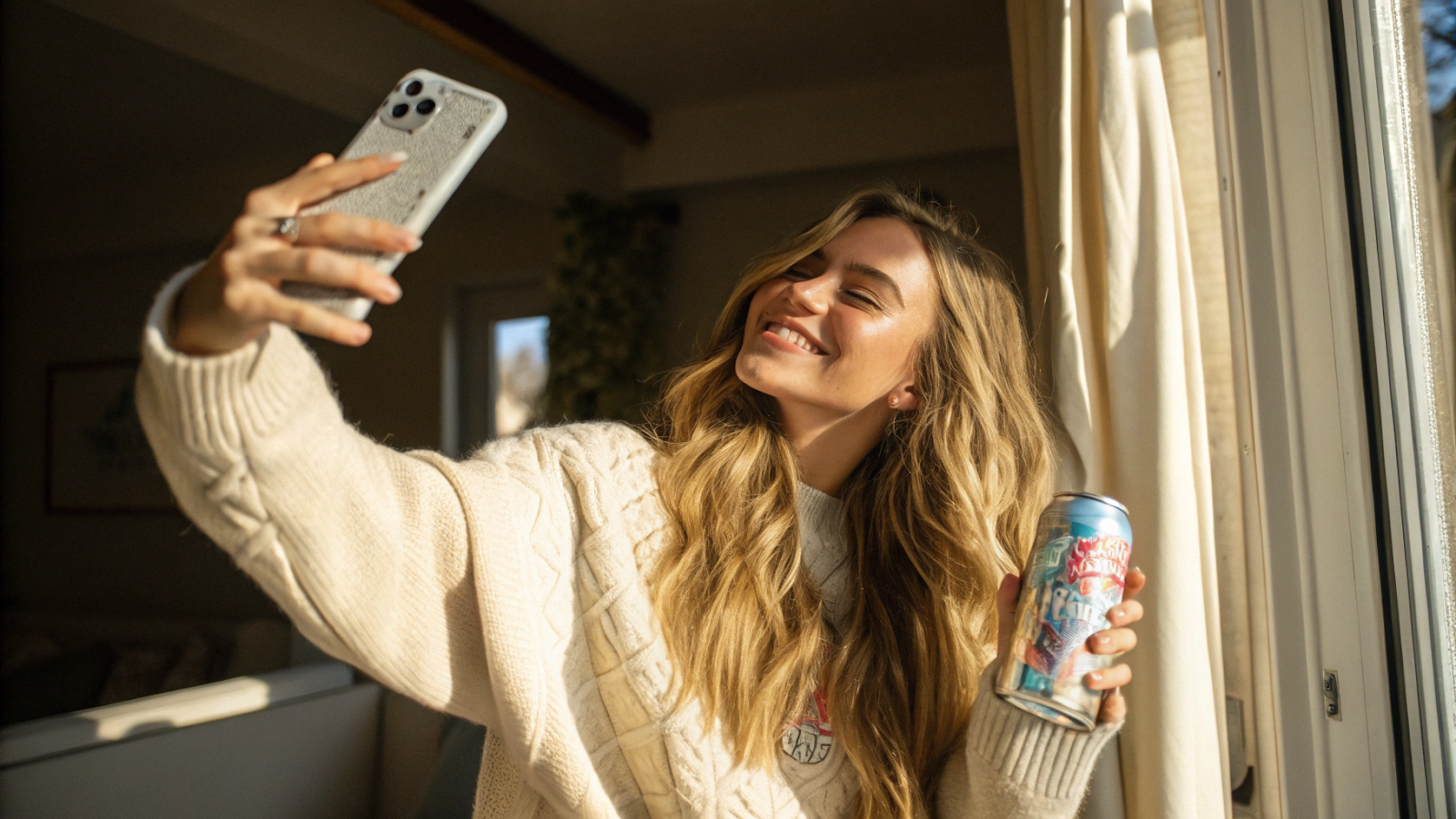Micro-influencers have proven that they don’t need millions of followers in order to successfully work with your brand and execute fantastic marketing campaigns. In this blog, you’ll learn exactly what micro-influencers are, the different ways they can benefit your business, and what to keep in mind when you’re partnering with them. We’ve also included real-world examples of businesses that are partnering with micro-influencers to get you thinking. Let’s dive in!

Here’s What a Micro-Influencer Is
Generally speaking, a micro-influencer is an influencer who has an audience of 10,000 to 100,000 followers. Because they have a smaller audience than other types of influencers, they can have more personal interactions and engage more frequently with their followers. Micro-influencers are often part of niche communities — like ASMR fans or Austin-based fitness clubs — and connect with unique social groups that aren’t as widely known. That makes them particularly valuable to brands trying to target smaller but more engaged audiences.
For a quick refresher, an influencer is simply someone with a following, typically an online audience they’ve built using social media platforms, a website, or a blog. There are influencers across industries and careers, all creating and sharing fresh, exciting content about their interests, ideas, and insights. Depending on who you ask, you’ll get slightly different answers on how many followers micro-influencers have. But the idea is that they have a higher follower count than a nano influencer and a lower follower count than a macro influencer:
- Nano-influencer: 1,000 to 10,000 followers
- Micro-influencer: 10,000 to 100,000 followers
- Macro-influencer: 100,000 to 1 million followers
- Mega-influencer: Over 1 million followers
Like all influencers, micro-influencers connect with audiences and increase brand awareness through collaborations using multiple social media channels including Instagram, YouTube, Pinterest, Facebook, and more.
7 Advantages of Micro-Influencer Marketing Campaigns
Partnering and strategizing with micro-influencers can unlock a variety of benefits for your brand, from building your brand reputation to improving your campaign conversion rates. Below, we’ll walk through the unique advantages of this type of partnership.
{{cta-banner-simple}}
1. Higher Audience Engagement Rates Than Average
Whether you want to share a new product launch or boost the sales of your most popular product, working with micro-influencers can help you do so. Micro-influencer campaigns regularly see high engagement levels and better marketing performance metrics. Why? At this stage, influencers have strong relationships with their followers. They respond quickly and frequently with personalized responses when their followers reach out. In turn, their audience trusts them — the things they say and the products and services that they promote. It’s much easier for impressions, clicks, and comments to turn into actionable conversions.
2. Access to Niche Communities
Micro-influencers tend to lead micro-communities, i.e., smaller audiences with a high affinity for a specific topic or industry. The channels where these niche consumers congregate, online or offline, are often harder to find or join. But with an “in” from a micro-influencer, you can access niche groups, test outreach tactics, and find success.
3. More Cost-Effective for Smaller Budgets
Another bonus? Micro-influencers typically charge much less than most other social media influencers and popular bloggers. In the content creator and influencer world, the amount you charge depends on a variety of things. For instance, a sponsored post with a simple text or image will cost less than a request for a 30-second video. However, follower count remains one of the biggest factors. Working with micro-influencers keeps your influencer marketing budget under control while maximizing impact with your target audience.
4. Accessible and Open to Feedback
Micro-influencers may be newer to the space and use each experience to learn and develop their own brand. As a result, they may be more open to project ideas, constructive feedback, and different compensation models (direct payments, free products, covered travel costs, etc). The micro-influencers you work with will likely manage themselves, unlike “A-list influencers.” (Think highly paid influencers like Eleonora Pons and the Gee family and celebrity influencers like Kim Kardashian.) That can make it easier for marketers to maintain control over campaigns and keep relationships strong.
5. Willing To Work With New or Small Brands
As the number of followers increases, influencers tend to become particular about which brands they create content for, limiting campaigns and sponsorships to reputable brands with plenty of social proof. By contrast, micro-influencers are more open to working with new brands, products, and services. Similar to your brand, they’re still building their following, so it doesn’t hurt to give a sponsorship or partnership a shot.
6. Open to Continuing Relationships As They Grow Their Influence
If the experience goes well for both the influencer and your business, they can serve as a brand ambassador and elevate your brand as they grow and establish more credibility within their space. Of course, campaign costs may rise as their audience reach expands. But when you get started with influencer marketing early, before they reach the next level, you can leverage that relationship to strike a better deal.
7. Authenticity and Trust Within Their Niche
As a marketer, you likely already know that people place the most trust in friend and family recommendations. In fact, 92% of consumers say they’re more likely to trust their peers over advertising. In niche communities, this goes double. Word-of-mouth recommendations reign supreme, and a testimonial or mention from a micro-influencer brings the weight of authenticity. As key opinion leaders in their niche — fandom, career, hobby, or otherwise — they know their audience demographic inside and out. It’s the kind of connection that can’t be bought, but that marketers can tap into through a micro-influencer campaign.
{{cta-banner-images}}
Potential Hurdles When Working With a Micro-Influencer
Now that we’ve covered the upsides to a micro-influencer partnership, let’s look at potential obstacles you should consider as you move forward.
Smaller Portfolios and Less Experience
If the micro-influencer lacks experience with brand partnerships, you may have to spend more time vetting influencers and managing the creator relationship. The logistical elements of working through a campaign from start to finish may be new, and they may not have a large portfolio for review. So, plan on giving additional guidance and direction (depending on the influencer).
Less Polished Social Feeds
Micro-influencers' feeds may not be as tightly curated, polished, or professional as their macro-influencer counterparts, which can impact your content’s discovery. If you’re promoting a beauty brand, for example, your posts may be competing with off-topic videos of the influencer’s friends and family or their food and lifestyle content.
How To Find and Manage Micro-Influencers
Although the spotlight is often on influencers and content creators in Los Angeles, New York City, and other major cities, you can activate influencers anywhere in the world. Here are two common methods to source and work with micro-influencers.
Option 1: Manually Search and Reach Out
You can discover micro-influencers by manually searching social media platforms and reaching out to candidates directly. Explore relevant hashtags and keywords on Google to surface relevant influencers. There are some disadvantages to this method. If you’re a small brand, it may be difficult to cut through the noise (direct messages, comments, etc) and successfully make a case for your brand. They may also question whether your business and/or offer are legitimate.
Option 2: Work With Agencies and Platforms That Connect Brands With Micro-Influencers
Today, there are influencer platforms and marketing agencies that can connect your business with influencers of all sizes. We’d know — From Popular Pays makes it easy to find and vet top-notch influencers, manage them, and track and analyze campaign performance.
Sort by follower size, social network, location, demographic, and skills, and find the perfect influencer for your brand. Request a demo to get started.
Which Industries Are Successfully Using Micro-Influencers? Examples From Top Brands
Micro-Influencers in the Health and Wellness Industry
One industry that’s booming thanks to influencer promotion is the health and wellness space. More and more people are looking to improve their self-care and achieve their best selves, especially following the COVID-19 pandemic. They’re hunting for trustworthy opinions on products and services across food, hair and skincare, tech apps, and other verticals.
Lululemon
Lululemon is a popular athleisure clothing brand that not only encourages physical fitness but overall wellness. In recent years, they’ve worked with influencers such as micro-influencer Michelle Carigma and macro-influencer Joe Wicks. They’ve found huge success with their brand ambassador program, honing their reach and attaining loyal customers using influencer activations.
{{cta-banner-text}}
Micro-Influencers in the Travel Industry
The travel industry has also exploded as a result of influencer activity. Travel micro-influencers are collaborating with companies from airlines and hotel chains to restaurants and luggage companies. They showcase beautiful destinations and diverse experiences to global audiences, giving brands plenty of ways to leverage partnerships.
Recommended Reading: What Is a Travel Influencer? Our Comprehensive Guide for 2021
Delta Airlines
A prime example of the travel industry using influential content creators is Delta Airlines. They activated a select group of influencers to launch their website for their new #SkyMilesLife mileage program. Their goal was to reach out to real-life people using relatable influencers. The result was a rich library of custom content for the company to use over a four-month period to promote domestic and international travel.
Micro-Influencers in the Retail and Appliance Industries
Finally, the retail and appliance industry is also finding its footing with influencer marketing. Check out this example.
JennAir
Luxury home appliance brand JennAir partnered with influencers for their complete brand revamp and relaunch. Unlike the other examples we’ve covered, the company built awareness using influencers at a live event. Their crew of creators shared a variety of content over 48 hours, including images and long-form videos, reaching an audience of 2.6 million Instagram followers and driving organic sales from the Architectural Digest Design Show.
Recommended Reading: 6 Examples of Brands Working With Micro-Influencers That Paid Off
Let From Popular Pays Connect You to the Right Influencers for Your Brand
Bigger isn’t always better. Micro-influencers can play a vital role in your digital marketing mix. When you identify the right partners for the job, micro-influencers can tell your brand story authentically, create product or service reviews, and generate high-quality leads better than their macro counterparts. The best part, it’s easy to test this strategy. From Popular Pays will help you discover, collaborate, and track campaigns with influencers in every niche and industry.

















